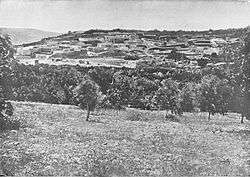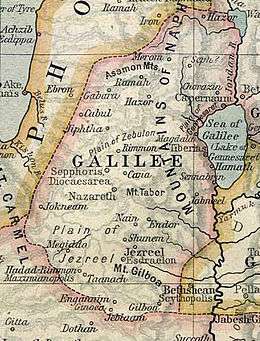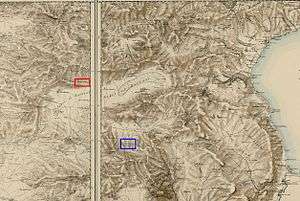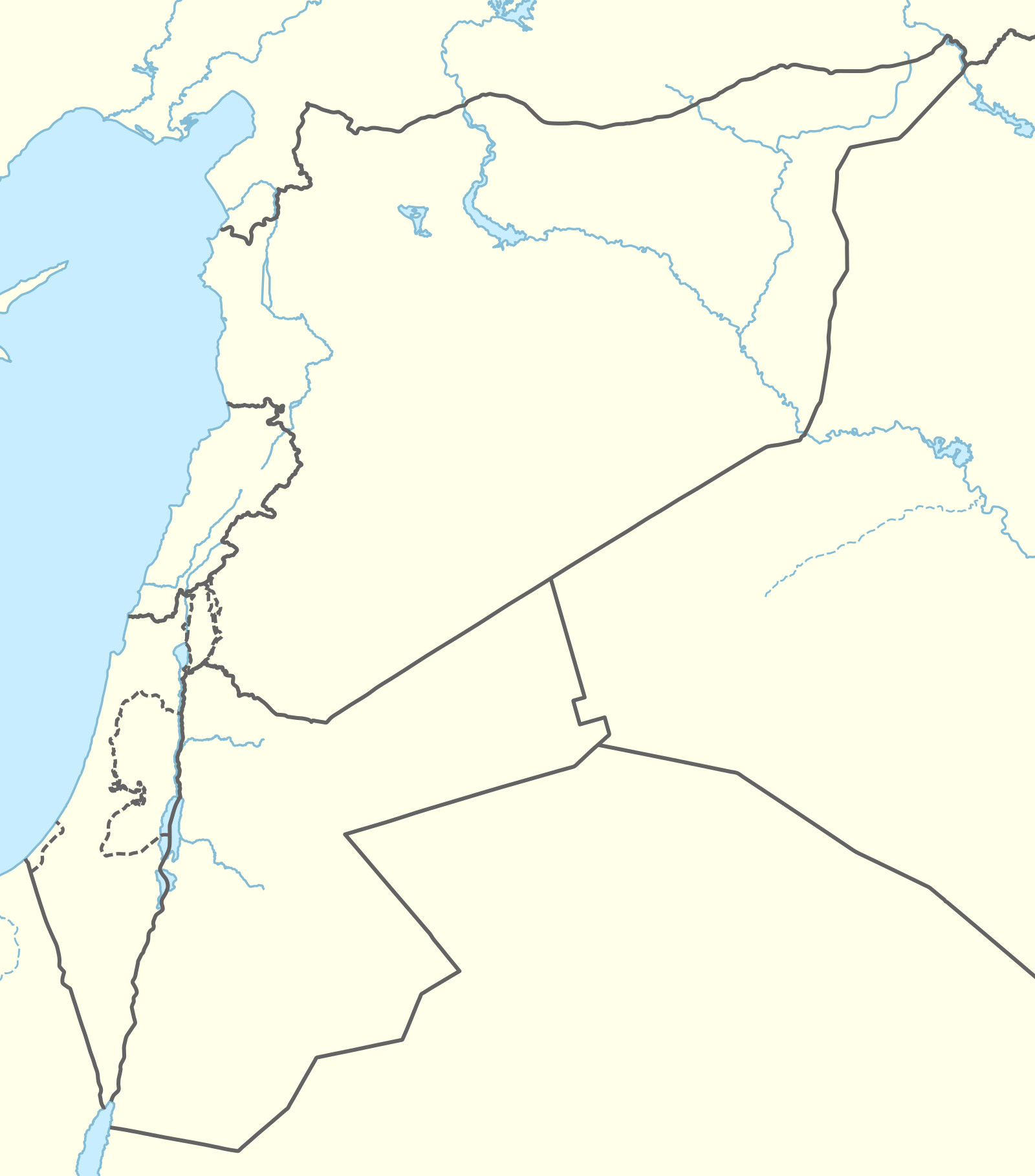Cana
Cana of Galilee (Ancient Greek: Κανὰ τῆς Γαλιλαίας, Arabic: قانا الجليل, romanized: Qana al-Jalil, lit. 'Qana of the Galilee') is the location of the Marriage at Cana, at which the miracle of turning water into wine took place in the Gospel of John.

The location is disputed, with the four primary locations being Kafr Kanna, Khirbet Qana and Reineh in Lower Galilee and Qana in Upper Galilee. The Arabic name "Qana al-Jalil" has been said to apply to a number of sites, but is of doubtful authenticity.[1] The name possibly derives from the Hebrew or Aramaic word for reeds.[2]
Written references to Cana
Biblical references

Among Christians and other students of the New Testament, Cana is best known as the place where, according to the Fourth Gospel, Jesus performed "the first of his signs", his first public miracle, the turning of a large quantity of water into wine at a wedding feast (John 2:1–11) when the wine provided by the bridegroom had run out. Although none of the synoptic gospels record the event, mainstream Christian tradition holds that this is the first public miracle of Jesus.[3]
The other biblical references to Cana are also in John: John 4:46, which mentions that Jesus is visiting Cana when he is asked to heal the son of a royal official at Capernaum; and John 21:2, where it is mentioned that Nathanael (sometimes identified with the Bartholomew included in the synoptic gospels' lists of apostles) comes from Cana.[4]
The Book of Joshua mentions one city (19:28) and one brook (16:8; 17:9) named Kanah (Cana) – neither is likely to be the Cana of Galilee.[4]
Other references
In secular history, the annals of Assyrian king Tiglath-Pileser III, who conquered the Galilee in a 733 BC campaign, contain a badly preserved list of cities[5] that had been thought to mention a certain Kana.[6][7] It relates that six hundred fifty captives were taken there. However, a revised transliteration revealed the one well-preserved syllable to be Ku, not Ka.[8]
Flavius Josephus mentions more than one place named Cana.[2][9] In the context of the Galilee, there are two mentions in his Life: one is a place on the road from Iulias,[10] and the other is a place where he resided, about a day's walk from Tiberias.[2][11]
Locating Cana

There has been much speculation about where Cana might have been. In his Gospel, the author makes no claim to have been at the wedding. Many would regard the story of the wedding at Cana as of theological rather than historical or topographical significance; it is the first of the seven miraculous "signs" by which Jesus's divine status is attested, and around which the gospel is structured.
The consensus of modern scholarship is that the Fourth Gospel was addressed to a group of Jewish Christians, and very possibly a group living in Judea province; so it is unlikely that the evangelist would have mentioned a place that did not exist. There is a minority view that the gospel was written for a gentile audience, and those who take this view assert that the description in the passage about the marriage at Cana of "six stone water jars there for the Jewish rites of purification", which does not reflect good knowledge of the actual ritual washing habits among Jews at the time, is specifically for a gentile audience, who would not know the topography of the Holy Land. On this hypothesis, the name "Cana" might have some purely symbolic significance.
There are four primary locations which have been under consideration as the New Testament Cana:[12]
- Upper Galilee
- Lower Galilee
- Kafr Kanna, Israel (also spelled Kefar Kenna)
- Karm er-Ras, the western part of Kafr Kanna[13]
- Khirbet Qana, Israel
- Ain Qana, Israel
- Kafr Kanna, Israel (also spelled Kefar Kenna)
Qana, Lebanon
The village of Qana, about 18 miles (29 km) from Tyre, Lebanon, is traditionally held to be the correct site by many Christians, and is Eusebius's pick in his 4th century Onomasticon.[2][14][15] In times of peace, it is a popular tourist site commemorating the miracle.[16]
Kafr Kanna and Karm er-Ras
The first time this site is associated with New Testament Cana is in a mid-17th century report to the Pope by Francesco Quaresimo, the papal emissary to Palestine, where he noted there were two possible candidates: Khirbet Qana and Kafr Kanna.[17] According to the Catholic Encyclopedia, a tradition dating back to the 8th century[18] identifies Cana with the modern Arab town of Kafr Kanna, at the foot of the Nazareth range, about 7 kilometres (4.3 mi) northeast of Nazareth.
Some scholars believe, according to archaeological evidence, that the identification of Kafr Kanna was the result of the decline of Khirbet Qana beginning in the Mamluk period. They note that it was a common practice for new and more affluent and easily accessible sites to be established in place of old ones to accommodate increases in pilgrim traffic, particularly in the late Medieval and Ottoman periods.[17]
Karm er-Ras, the western part of Kafr Kanna, was recently excavated by Israeli archaeologist Yardenna Alexandre.[13] The excavation revealed evidence of a substantial Roman village with a Jewish population which declined considerably in the Late Roman period, and which was finally abandoned in the Byzantine Period, explaining why the pilgrim route was shifted to Kafr Kanna. Alexandre believes the site is precisely identified by Josephus, but other scholars disagree.[16]
Khirbet Kana, Israel
Another possible candidate is the ruined village of Khirbet Qana, meaning "the ruins of Cana." Overlooking the Beit Netofa Valley from the north, it is located about 9 kilometres (5.6 mi) north of Kafr Kanna and has been noticed by pilgrims since the 12th century or earlier.[19] However, this could either be an ancient retention, as Edward Robinson maintained,[19] or may have been attached to the place in conversation with querying pilgrims.[2]
This site is located on a limestone outcropping that rises 330 feet (100 m) above the floor of the Bet Netofa Valley, 8 miles (13 km) from Nazareth and 5 miles (8.0 km) northeast of Sepphoris in lower Galilee. It also has long been identified as the true location of New Testament Cana. Excavations by archaeologist Douglas Edwards of the University of Puget Sound and archaeologist Tom McCollough reveal architectural and numismatic remains demonstrating that the site contained a modest-sized village from the Hellenistic period onward (c. 200 BCE–650 CE), including a structure that bears similarities to Roman-period synagogues, and several mikveh pools for Jewish ceremonial bathing.[20] Most importantly, they uncovered a cave complex on the south slope of the site that showed indications of use as a center for worship, including a sarcophagus lid or altar and a shelf that held two stone vessels in situ, and space for another four vessels, suggesting that Khirbet Kana was regarded as New Testament Cana from a very early time. Remains of an Arab village and a church or monastery were also uncovered immediately south of the cave complex.
Other historical evidence from the Byzantine and Medieval periods show that Khirbet Kana was regarded as the true site of New Testament Cana from a very early period. A guidebook written by Theodosius between 517 and 527 CE titled The Layout of the Holy Land identifies Khirbet Kana and indicates that two of the vessels were still at the location. A pilgrim account written by Saewulf in 1101 to 1103 CE also identifies the site, as do Belard of Ascoli (c. 1155 CE) and Dominican friar Burchard of Mount Sion (1283 CE), and a map by noted cartographer Petrus Vesconte in 1321 CE. Burchard of Mount Sion describes a cave complex located there that was used as a veneration site: "the place is shown at this day where the six water pots stood, and the dining-room where the tables were placed."[20]
Reineh, Israel
.jpg)
Just south of the town of Reineh, about a mile from Nazareth, a small spring named "Ain Kana" was identified in 1878 by Claude Reignier Conder as the location of Cana.[21] Some early Christian pilgrim reports mention a spring in association with the Cana of Galilee, but no excavations have been conducted there yet.[16] Ain Qana is considered by some to be a better candidate based on etymological grounds.
References
- Masterman 1910, p. 80-81: "This Khurbet Kana was reidentified by the late Dr. Robinson as Cana of Galilee, but he unfortunately reported that it was called by the natives Kana el Jalil = Cana of Galilee. Were this the universal custom it would no doubt be an important confirmation of this view, but this is far from being the case; indeed, such a name is unknown to the unsophisticated fellahin. On my recent visit there I had as guide a very intelligent native of Reineh who told me he had never heard any other name than Khurbet Kana, and whose answer to my question as to where was Kana el Jalil was "In the gospel." Far more important is the testimony of the late Rev. T. Zeller of the Church Missionary Society, who passed many years in Nazareth, that he never heard such a name. In any argument regarding this site it is better to neglect the name Kana el Jalil as of altogether doubtful authenticity. Unfortunately the discrediting of this name has been used as an argument against the site."
- Ewing, W (1915). "Cana". In Orr, James (ed.). International Standard Bible Encyclopedia. Retrieved 2014-04-28.
- Towner, W. S. (1996), Wedding, in P. J. Achtermeier (Ed.), Harper Collins Bible dictionary (pp. 1205–1206). San Francisco: Harper
- Ewing, W. (1915). "Kanah". In Orr, James (ed.). International Standard Bible Encyclopedia. Retrieved 2014-05-28.
- Tadmor, Hayim; Yamada, Shigeo (eds.). "Tiglath-pileser III 22". RINAP: Royal Inscriptions of the Neo-Assyrian Period. ORACC. Retrieved 13 May 2014., also in ISBN 978-1-57506-220-4, p. 61ff.
- Benjamin Mazar identifies it with Cana "without doubt": Maisler, B (April 1933). מסע תגלת פלאסר השלישי לא"י בשנת 732 [The expedition of Tiglath Pileser III to Palestine in 732 B.C.]. Yediʻot ha-Ḥevrah ha-ʻIvrit la-ḥaḳirat Erets-Yiśraʼel ṿe-ʻatiḳoteha [Bulletin of the Jewish Palestine Exploration Society / Bulletin of the Israel Exploration Society] (in Hebrew). 1 (1). OCLC 7858680. Retrieved 2014-05-15. In Digital Library for International Research Archive, Item #1599.
- The translations of the inscription by Smith, Rost and Oppenheim all sport the same name.
- Smith, George (1875). Assyrian Discoveries: An Account of Explorations and Discoveries on the site of Nineveh, during 1873 and 1874. New York: Scribner, Armstrong & Co. p. 283. OCLC 182847392. Retrieved 2014-05-17.
- Rost, Paul, chapter translator (orig. 1893). Luckenbill, Daniel David, ed. (November 1926). "§779". Historical Records of Assyria: From the Earliest Times to Sargon. Ancient records of Assyria and Babylonia. 1. Chicago: University of Chicago Press. p. 280. Retrieved 2014-05-18.
- A. Leo Oppenheim, chapter translator. Pritchard, James B, ed. (1969). Ancient Near Eastern Texts: Relating to the Old Testament (Third edition with supplement ed.). Princeton, N.J.: Princeton University Press. p. 283. ISBN 9780691035031.
- Tadmor, Hayim (1967). "כיבוש הגליל בידי תגלת פלאסר הג'" [The conquest of Galilee by Tiglath-Pileser III]. In Hirschberg, Haïm Zeev; Aviram, Yosef (eds.). כל ארץ נפתלי / Kol erets Naftali [All the land of Naphtali : the twenty-fourth Archaeological Convention, October 1966] (in Hebrew). Yerushalayim: ha-Ḥevrah la-ḥaḳirat Erets-Yiśraʼel ṿe-ʻatiḳoteha. pp. 63–64. OCLC 19147471.
- Williams, George (1854). "Cana". In Smith, William (ed.). Dictionary of Greek and Roman Geography – via Perseus Project.
- Mason, Steve (ed.). "The Life of Flavius Josephus, Niese sec. 395". Brill/PACE.
- Mason, Steve (ed.). "The Life of Flavius Josephus, Niese sec. 84-87". Brill/PACE.
- McCollough 2015, p. 32.
- Alexandre, Y. (2017). Karm er-Ras (Areas AB, AC): Final Report. Hadashot Arkheologiyot: Excavations and Surveys in Israel / חדשות ארכיאולוגיות: חפירות וסקרים בישראל, 129. Retrieved July 22, 2020, from www.jstor.org/stable/26693775
- Eusebius, of Caesarea (2006) [manuscript, 1971]. "Kappa, in Joshua". In Wolf, Carl Umhau (ed.). The Onomasticon of Eusebius Pamphili, Compared with the Version of Jerome and Annotated. tertullian.org. Retrieved 7 May 2014.
- Eusebius, of Caesarea (1904). Klostermann, Erich (ed.). Das Onomastikon der Biblischen Ortsnamen. Die griechischen christlichen Schriftsteller der ersten drei Jahrhunderte (in Greek and Latin). Leipzig: J. C. Hinrichs. pp. 116–117. OCLC 490976390. Retrieved 2014-05-06.
- McCollough 2015, p. 39.
- McCollough 2015, p. 38.
- Ward, B. (1908). "Cana". Catholic Encyclopedia. 3. New York: Robert Appleton Company.
- Robinson, Edward; Eli Smith (1841). Biblical researches in Palestine (1st ed.). Boston: Crocker & Brewster. OCLC 586068890. Retrieved 2014-06-21. pp. 204-208.
- McCollough 2015.
- Conder, Claude Reignier (1878). Tent Work in Palestine: A Record of Discovery and Adventure. R. Bentley & Son. p. 154.
External links
| Wikisource has the text of the 1879 American Cyclopædia article Cana. |
- Comprehensive list of online resources and references relating to John 2:1–11 at The Text This Week
- Entry on Cana in Easton's Bible Dictionary (1897)
- "Khirbet Qana, a Galilean Village in Regional Perspective: Survey and Excavation, 1997–2004". University of Puget Sound. 2011. Retrieved 2014-05-02.
- Masterman, E. W. G. (1910). "Cana of Galilee". The Biblical World. 36 (2): 79–92. JSTOR 3141390. (free access)
- McCollough, Tom (2015). "Searching for Cana Where Jesus Turned Water into Wine". Biblical Archaeology Review. 41 (6): 31–38.
